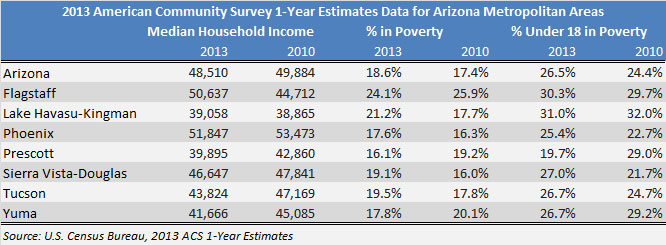By Valorie Rice, EBRC Senior Business Information Specialist
September 19, 2014
The poverty rate for the United States decreased to 14.5% in 2013 from 15% in 2012 , according to the Census Bureau publication Income and Poverty in the United States: 2013, released Tuesday, September 16th. This was the first significant decrease in poverty in seven years for the U.S. The U.S. poverty rate has been hovering close to 15% for the last three years, and remains higher than it was both before and during the Great Recession. This national data release was based on the Current Population Survey, Annual Social and Economic Supplement. Poverty estimates for state and local areas are derived from the American Community Survey which was released on Thursday, September 18th.
These just released American Community Survey (ACS) 2013 one-year estimates provide demographic and socioeconomic data at the state, metro, and large county geographies. While Arizona’s poverty rate declined slightly between 2012 (18.7%) and 2013 (18.6%), it remains higher than the 17.4% estimate for 2010, the first full year after the Great Recession. Here are some data for Arizona and its seven metropolitan areas, comparing 2013 data with 2010. Only Flagstaff and Lake Havasu City-Kingman had a higher median household income in 2013. Overall poverty rates and the rate of children (under age 18) living in poverty worsened for most metro areas in the state, with a few exceptions, most notably Prescott. The poverty rate for Prescott went from 19.2% in 2010 to 16.1% in 2013 and the rate for children decreased 9.3 percentage points in that time.
Gross domestic Product (GDP) by metropolitan areas for 2013 was released September 16th. Real GDP increased in 76.6% of the 381 metropolitan areas, with four Arizona metro areas among that list. All metro areas combined had a 1.7% increase in GDP for 2013 compared to 2.6% in 2012. The 2013 percent change in GDP for Arizona metro areas: Flagstaff (2.1), Lake Havasu-Kingman (-0.7), Phoenix-Mesa-Scottsdale (1.2), Prescott (2.2), Sierra Vista-Douglas (-1.3), Tucson (0.3), and Yuma (-1.1).
The Bureau of Labor Statistics released the August Producer Price Index on September 16th. The index for final demand was unchanged for the month, as final demand goods decreased by 0.3% while final demand services increased 0.3%. The 12-month change in wholesale prices was 1.8% in August.
The Consumer Price Index for August declined 0.2% on a seasonally adjusted basis, according to the September 17th release. This was the first time since April 2013 for a monthly decline in prices. The index for all items less food and energy was unchanged, while food and shelter were up slightly, leaving energy as the primary reason for the decline in overall prices. The energy index decreased 2.6% in August. The 12-month inflation rate was 1.7%.
Arizona initial unemployment claims were again lower the first week of September, dropping below the 4,000 mark at 3,741. The four-week average was also lower at 4,160. The number of weekly jobless claims dropped substantially the second week of September to a seasonally adjusted 280,000 while the four-week average moved down to 299,500.
County employment and wages data for the 1st quarter 2014 were released Thursday. The average weekly wage increased 3.3% in Maricopa and 1.5% in Pima between the 1st quarter 2013 and 1st quarter 2014. Average weekly wages increased 3.1% in the state during the same time period.
The Arizona employment report for August was released September 18th. The state added 39,500 nonfarm jobs for the month before seasonal adjustment. The year-over-year change in employment for the state was 2.1% compared to 1.8% for the U.S. The biggest gain in employment over the year was education and health services while both the information and construction sectors had job losses. Arizona’s unemployment rate rose to 7.1% for August, which was 1% lower than in August of last year.
Arizona was among 24 states with unemployment rate increases in August, according to the September 19th Bureau of Labor Statistics state employment report. Eleven states had no change in unemployment rates while 15 had decreases in rates. North Dakota remains the state with the lowest unemployment rate of 2.8%. Georgia has the highest unemployment rate of all states, 1% higher than Arizona and 2% higher than the U.S.
September 12, 2014
Arizonans filed 1,623 bankruptcies in August, down from 1,764 in July. Year-to-date there has been 13,504 bankruptcies filed in the state compared to 15,266 at this point in 2013, an 11.5% drop in filings. Eleven Arizona counties had a decrease in year-to-date bankruptcies, three counties (Cochise, Graham, and La Paz) had the same number as this time last year, and only Yuma had an increase in year-to-date filings over August of last year.
Initial unemployment claims in Arizona continued to move downward throughout August, with 4,221 claims the last week of the month. The four-week average was lower for the sixth straight week, at 4,421 compared to 4,552 the week prior. Jobless claims nationally rose the first week of September, putting the seasonally adjusted figure at 315,000, which was the highest since June. The four-week average was also slightly higher at 304,000.






